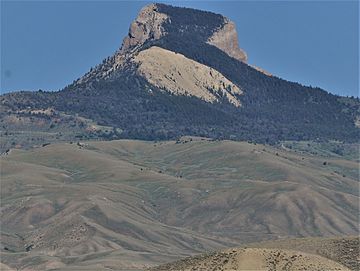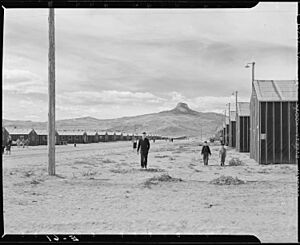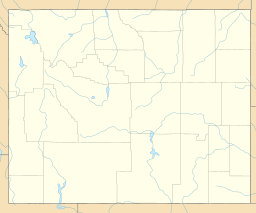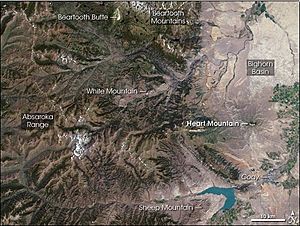Heart Mountain (Wyoming) facts for kids
Quick facts for kids Heart Mountain |
|
|---|---|
 |
|
| Highest point | |
| Elevation | 8,123 ft (2,476 m) |
| Prominence | 2,163 ft (659 m) |
| Geography | |
| Topo map | USGS Heart Mountain |
| Geology | |
| Mountain type | Limestone |
Heart Mountain is a very tall mountain in Wyoming, U.S.. It stands about 8,123 feet (2,476 meters) high. You can find it just north of Cody. This mountain is famous for a big mystery: its top rocks are much, much older than the rocks at its base!
Contents
Heart Mountain: A Moving Mystery
Heart Mountain is made of limestone and dolomite. These rocks are very old, about 500 to 350 million years old. But the rocks at the bottom of the mountain are only about 55 million years old. This means the rocks on top are almost 300 million years older than the rocks below them! For over 100 years, scientists have wondered how these older rocks ended up on top of much younger ones.
Where Did Heart Mountain Come From?
The rocks that make up Heart Mountain were once at the bottom of a warm, shallow sea. This was a very long time ago. These rocks were originally located about 25 miles (40 kilometers) to the northwest. Today, that area is where the eastern Absaroka Range stands.
The Great Rock Slide: How a Mountain Moved
Between 75 and 50 million years ago, a time of big mountain-building happened. This period is called the Laramide Orogeny. It pushed up the Beartooth Range and made the land sink in other areas.
Right after this, volcanoes started to erupt. These volcanoes formed the Absaroka Range. Then, between 50 and 48 million years ago, something amazing happened. A huge sheet of rock, about 500 square miles (1,300 square kilometers) in size, broke off. It slid many miles to the southeast and south.
This giant rock sheet was very thick, about 2.5 to 3 miles (4 to 5 kilometers). Even though the ground was only slightly sloped, this huge landslide traveled at least 25 miles (40 kilometers). It ended up covering more than 1,300 square miles (3,400 square kilometers). This was the biggest rockslide ever known on land!
What Made the Mountain Slide?
Scientists have many ideas about how this huge rock slab slid so far. Most agree that the volcanic eruptions in the Absaroka Range played a part. Some think a big volcanic explosion or a steam explosion started the movement.
Another idea is that hot, pressurized water helped. This water might have come from a volcano. It could have acted like a lubricant, making the rocks slide easily.
One exciting idea is that when the slide started moving, the rubbing (friction) heated the rocks. This heat could have created a special material. This material then broke down into gas, like carbon dioxide. This gas could have formed a cushion, like a hovercraft. This cushion would have let the mountain slide easily down the gentle slope.
Scientists believe the front of the sliding mountain moved very fast. It might have gone over 100 miles per hour (160 kilometers per hour). This means the mountain traveled to its current spot in about 30 minutes!
Heart Mountain Today
In the 48 million years since the slide, wind and water have worn away most of the rock sheet. What is left is one big block of rock: Heart Mountain. Another large block of rock, Sheep Mountain, is farther south.
You can see the place where the slide happened, called the Heart Mountain fault. It is best seen along the Chief Joseph Highway (Wyoming Highway 296). It looks like a very straight line on the side of Cathedral Cliffs.
Heart Mountain in History
The mountain also gave its name to a special place nearby. This was the Heart Mountain War Relocation Center. During World War II, many Japanese Americans were sent there.





